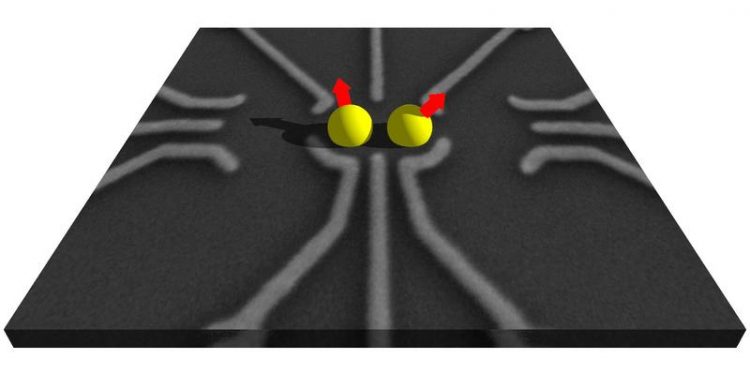Improved Stability of Electron Spins in Qubits

Double quantum dot: The three lower and upper contacts trap up to two individual electrons, the spin states of which form the quantum-mechanical information unit. University of Basel
The basic idea of a quantum computer is to replace the ones and zeros used in today’s bits with quantum states, or qubits. Qubits are units of information that not only assume the values zero and one, but in which zero and one are possible at the same time, and in any chosen combination, in the form of a quantum superposition.
Qubits can, for example, be implemented using the spins of individual electrons held in nanoscale structures made of semiconducting material, known as quantum dots. By exploiting quantum-mechanical principles such as superposition, a quantum computer can achieve enormous processing speeds – but only if the electron spins persist for long enough.
In recent years, it has been possible to extend this so-called coherence time to over a millisecond, thanks to the successful reduction of interference caused by nuclear spins. Thus, the search for other factors that affect the stability of the electron spins increased in importance.
Discovery of electron exchange
Physicists at the University of Basel and the Swiss Nanoscience Institute have now established that qubits’ coherence is limited by a process in which individual electrons are exchanged between a quantum dot and an external reservoir. The reservoir represents a type of electrode that is in contact with the quantum dot and is required for the measurements.
The researchers, led by Professor Dominik Zumbühl, observed that thermal excitation prompts an electron to jump from the quantum dot into the reservoir, and that shortly thereafter an electron jumps from the reservoir into the quantum dot.
This exchange creates a short-lived charge state, which the researchers in Basel have now been able to demonstrate for the first time with a charge sensor. The exchange process also leads to a randomizing of the electron spins, through which quantum information is lost.
Fundamental process for coherence
Based on the experimental observations, the researchers were able to significantly extend the existing theoretical description of double quantum dots, which can contain two electrons. They also succeeded in influencing the intensity of the temperature-dependent exchange process by cooling the electrons down to 60 millikelvins. At the same time, the process was slowed and the stability of the spins prolonged by changing the voltages at the entrances, or gates, to the quantum dot.
An understanding and control of this exchange process, which is fundamental to quantum dots, paves the way for further progress in qubit coherence. At the same time, it opens the way to a quick generation of desired spin states in quantum dots.
Implementation of a theoretical concept with Basel roots
This approach, whereby quantum dots in semiconductors are exploited in order to use the spin of an individual electron as a qubit, can be traced back to Prof. Daniel Loss of the University of Basel and the American physicist David DiVincenzo. Their concept, which they originally presented in 1998, has the potential to allow the creation of quantum computers with a large number of connected spin qubits. The current study was carried out in collaboration with researchers from the University of St Andrews (GB) and the University of California, Santa Barbara (US).
Original source
D. E. F. Biesinger, C. P. Scheller, B. Braunecker, J. Zimmerman, A. C. Gossard, D. M. Zumbühl
Intrinsic Metastabilities in the Charge Configuration of a Double Quantum Dot
Physical Review Letters 115 (2015), doi: 10.1103/PhysRevLett.115.106804
Further information
Prof. Dr. Dominik Zumbühl, University of Basel, Department of Physics, Tel. +41 61 267 36 93, email: dominik.zumbuhl@unibas.ch
https://www.unibas.ch/en/News-Events/News/Uni-Research/Improved-Stability-of-Ele…
Media Contact
All latest news from the category: Physics and Astronomy
This area deals with the fundamental laws and building blocks of nature and how they interact, the properties and the behavior of matter, and research into space and time and their structures.
innovations-report provides in-depth reports and articles on subjects such as astrophysics, laser technologies, nuclear, quantum, particle and solid-state physics, nanotechnologies, planetary research and findings (Mars, Venus) and developments related to the Hubble Telescope.
Newest articles

Properties of new materials for microchips
… can now be measured well. Reseachers of Delft University of Technology demonstrated measuring performance properties of ultrathin silicon membranes. Making ever smaller and more powerful chips requires new ultrathin…

Floating solar’s potential
… to support sustainable development by addressing climate, water, and energy goals holistically. A new study published this week in Nature Energy raises the potential for floating solar photovoltaics (FPV)…

Skyrmions move at record speeds
… a step towards the computing of the future. An international research team led by scientists from the CNRS1 has discovered that the magnetic nanobubbles2 known as skyrmions can be…





















